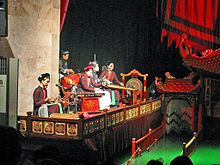Múa rối nước

Water puppetry (Vietnamese: Múa rối nước, lit. "puppets that dance on water") is a tradition that dates back as far as the 11th century CE when it originated in the villages of the Red River Delta area of northern Vietnam. Today's Vietnamese water puppetry is a unique variation on the ancient Asian puppet tradition.[1]
The puppets are made out of wood and then lacquered. The shows are performed in a waist-deep pool. A large rod supports the puppet under the water and is used by the puppeteers, who are normally hidden behind a screen, to control them. Thus the puppets appear to be moving over the water. When the rice fields would flood, the villagers would entertain each other using this form of puppet play.
History

Múa rối nước is considered to have originated in the delta of the Red river in Vietnam in the 11th century, and the art remains highly developed today in this country. Some of the earliest troupes were found in the Nguyên Xá commune, Đông Hưng district, Thai Binh province.[1]
In ancient Vietnam, the rural Vietnamese believed that spirits controlled all aspect of their lives, from the kitchen to the rice paddies. The Vietnamese devised water puppetry as a way to satisfy these spirits, and as a form of entertainment, using what natural medium they could find in their environment. In ancient times, the ponds and flooded rice paddies after harvest were the stage for these impromptu shows. [2]
This art form is unique to North Vietnam and only found its way to the world stage in recent years as a result of normalized relations with the West.[3] During the early 1990s the country's three foremost companies, the National Puppet Theatre (Nhà hát Múa rối Trung Ương), the municipal Thăng Long Puppet Company (Nhà hát Múa rối Thăng Long) of Hanoi and the Hồ Chí Minh City Puppet Company (Đoàn Nghệ thuật Múa rối Thành Phố Hố Chí Minh) gained increased international attention. The main venues in Vietnam itself are the Thăng Long Water Puppet Theatre in Hanoi and the Golden Dragon Water Puppet Theatre in Saigon.
Performance



Modern water puppetry is performed in a pool of water 4 meters square with the water surface being the stage. Performance today occurs on one of three venues—on traditional ponds in villages where a staging area has been set up, on portable tanks built for traveling performers, or in a specialized building where a pool stage has been constructed[4].
Up to 8 puppeteers stand behind a split-bamboo screen, decorated to resemble a temple facade, and control the puppets using long bamboo rods and string mechanism hidden beneath the water surface. The puppets are carved out of wood and often weigh up to 15 kg.
A traditional Vietnamese orchestra provides background music accompaniment. The instrumentation includes vocals, drums, wooden bells, cymbals, horns, Đàn bầu (monochord), gongs, and bamboo flutes. The bamboo flute's clear, simple notes may accompany royalty while the drums and cymbals may loudly announce a fire-breathing dragon's entrance.[5]
Singers of chèo (a form of opera originating in north Vietnam) sing songs which tell the story being acted out by the puppets. The musicians and the puppets interact during performance; the musicians may yell a word of warning to a puppet in danger or a word of encouragement to a puppet in need.
The puppets enter from either side of the stage, or emerge from the murky depths of the water.
Spotlights and colorful flags adorn the stage and create a festive atmosphere.
Content
The theme of the skits is rural and has a strong reference to Vietnamese folklore. It tells of day-to-day living in rural Vietnam and Vietnamese folk tales that are told by grandparents to their grandchildren. Stories of the harvest, of fishing and of festivals are highlighted.
Legends and national history are also told through short skits. Many of the skits, especially those involving the tales of day-to-day living, often have a humorous twist.
References
- ^ a b "Việt Nam Cultural Profiles: Puppetry". Cultural Profiles Project. 2006. Retrieved 2009-01-23.
{{cite web}}: Unknown parameter|month=ignored (help) - ^ Eckersley. M.(ed.) 2009. Drama from the Rim: Asian Pacific Drama Book. Drama Victoria. Melbourne. 2009. (p46)
- ^ "Words on a wire". Vietnam Investment Review. 2002. Retrieved 2009-01-23.
{{cite web}}: Unknown parameter|month=ignored (help) - ^ Eckersley. M.(ed.) 2009. Drama from the Rim: Asian Pacific Drama Book. Drama Victoria. Melbourne. 2009. (p44)
- ^ "The long cultural strings of Water Puppetry". VietNamNet. 14 August 2003. Retrieved 2009-01-23. [dead link]
Literature
- Nguyễn, Huy Hồng (2006). Vietnamese Traditional Water Puppetry. Hanoi: Thế Giới Publishers. p. 79.
External links
![]() Media related to Múa rối nước at Wikimedia Commons
Media related to Múa rối nước at Wikimedia Commons
- Thang Long Water Puppet Theatre Homepage
- Vietnamese water puppet show with video
